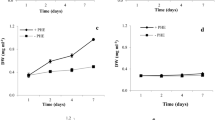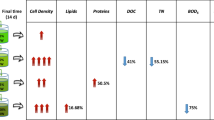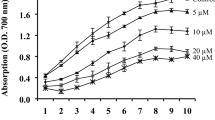Abstract
Microalgae are increasingly recognized as promising organisms for bioremediation of organic pollutants. This study investigates the potential of enhancing the bioremediation efficiency of pyrene (PYR), a polycyclic aromatic hydrocarbon (PAH), through NaCl induced physiological and biochemical alterations in two microalgae species, Chlorella vulgaris and Scenedesmus acutus. Our findings reveal significant improvement in PYR removal when these microalgae were cultivated in the presence of 0.1% NaCl where PYR removal increased from 54 to 74% for C. vulgaris and from 26 to 75% for S. acutus. However, it was observed that NaCl induced stress had varying effects on the two species. While C. vulgaris exhibited increased PYR removal, it experienced reduced growth and biomass production, as well as lower photosynthetic efficiency when exposed to PYR and PYR + NaCl. In contrast, S. acutus displayed better growth and biomass accumulation under PYR + NaCl conditions, making it a more efficient candidate for enhancing PYR bioremediation in the presence of NaCl. In addition to assessing growth and biochemical content, we also investigated stress biomarkers, such as lipid peroxidation, polyphenol and proline contents. These findings suggest that S. acutus holds promise as an alternative microalgae species for PYR removal in the presence of NaCl, offering potential advantages in terms of bioremediation efficiency and ecological sustainability. This study highlights the importance of understanding the physiological and biochemical responses of microalgae to environmental stressors, which can be harnessed to optimize bioremediation strategies for the removal of organic pollutants like PYR.




Similar content being viewed by others
Data availability
Not applicable.
Abbreviations
- Chl:
-
Chlorophyll
- MDA:
-
Malondialdehyde
- PAHs:
-
Polycyclic aromatic hydrocarbons
- PYR:
-
Pyrene
- SP:
-
Saturation pulse
- Y(II):
-
Quantum yield of PSII
- Y(NO):
-
Yield of non-regulated energy dissipation
- Y(NPQ):
-
Yield of regulated energy dissipation
References
Adelaja O, Keshavarz T, Kyazze G (2015) The effect of salinity, redox mediators and temperature on anaerobic biodegradation of petroleum hydrocarbons in microbial fuel cells. J Hazard Mater 283:211–217
Arora K, Kumar P, Bose D, Li X, Kulshrestha S (2021) Potential applications of algae in biochemical and bioenergy sector. 3 Biotech 11:296
Arulazhagan P, Vasudevan N, Yeom IT (2010) Biodegradation of polycyclic aromatic hydrocarbon by a halotolerant bacterial consortium isolated from marine environment. Int J Environ Sci Technol 7:639–652
Bao M, Xing Q, Park J-S, He P, Zhang J, Yarish C, Kim JK (2023) Temperature and high nutrients enhance hypo-salinity tolerance of the bloom forming green alga. Ulva Prolifera Harmful Algae 123:102402
Bates LS, Waldren RP, Teare ID (1973) Rapid determination of free proline for water-stress studies. Plant Soil 39:205–207
Bews E, Booher L, Polizzi T, Long C, Kim JH, Edwards MS (2021) Effects of salinity and nutrients on metabolism and growth of Ulva lactuca: implications for bioremediation of coastal watersheds. Mar Pollut Bull 166:112199
Borecka M, Białk-Bielińska A, Haliński ŁP, Pazdro K, Stepnowski P, Stolte S (2016) The influence of salinity on the toxicity of selected sulfonamides and trimethoprim towards the green algae Chlorella vulgaris. J Hazard Mater 308:179–186
Chokshi K, Pancha I, Ghosh A et al (2017) Nitrogen starvation-induced cellular crosstalk of ROS-scavenging antioxidants and phytohormone enhanced the biofuel potential of green microalga Acutodesmus dimorphus. Biotechnol Biofuels 10:60
Chowdury K, Nahar N, Deb U (2020) The growth factors involved in microalgae cultivation for biofuel production: a review. Comput Water Eng Environ Eng 9:185–215
Coulombier N, Jauffrais T, Lebouvier N (2021) Antioxidant compounds from microalgae: a review. Mar Drugs 19:549
Dere S, Gunes T, Sivaci R (1998) Spectrophotometric determination of chlorophyll-a, b and total carotenoid contents of some algae species using different solvents. Turk J Bot 22:13–17
Dhar K, Subashchandrabose SR, Venkateswarlu K, Krishnan K, Megharaj M (2020) Anaerobic microbial degradation of polycyclic aromatic hydrocarbons: a comprehensive review. Rev Environ Contam Toxicol 251:25–108
Foflonker F, Ananyev G, Qiu H, Morrison A, Palenik B, Dismukes GC, Bhattacharya D (2016) The unexpected extremophile: tolerance to fluctuating salinity in the green alga Picochlorum. Algal Res 16:465–472
Jain L, Jajoo A (2020) Protection of PSI and PSII complexes of wheat from toxic effect of anthracene by Bacillus Subtilis (NCIM 5594). Photosynth Res 146:197–211
Kandasamy S, Narayanan M, He Z, Liu G, Ramakrishnan M, Thangavel P, Pugazhendhi A, Raja R, Carvalho IS (2021) Current strategies and prospects in algae for remediation and biofuels: an overview. Biocatal Agric Biotechnol 35:102045
Khona DK, Shirolikar SM, Gawde KK, Hom E, Deodhar MA, D’Souza JS (2016) Characterization of salt stress-induced palmelloids in the green alga, Chlamydomonas reinhardtii. Algal Res 16:434–448
Lawal AT (2017) Polycyclic aromatic hydrocarbons. A review. Cogent Environ Sci 3:1
Li Y, Li W, Ji L, Song F, Li T, Fu X, Li Q, Xing Y, Zhang Q, Wang J (2022) Effects of salinity on the biodegradation of polycyclic aromatic hydrocarbons in oilfield soils emphasizing degradation genes and soil enzymes. Front Microbiol 12:824319
Lin CH, Lee CY, Liu WD, Chang YJ (2010) Substrate interactions during the biodegradation of benzene and toluene hydrocarbons at various salinities. J Biotechnol 150:241–242
Lopez A, Rico M, Rivero A, Tangil MS (2011) The effects of solvents on the phenolic contents and antioxidant activity of Stypocaulon scoparium algae extracts. Food Chem 125:1104–1109
Luo W, Hai FI, Kang J, Price WE, Guo W, Ngo HH, Yamamoto K, Nghiem LD (2015) Effects of salinity build-up on biomass characteristics and trace organic chemical removal: implications on the development of high retention membrane bioreactors. Bioresour Technol 177:274–281
Markou G, Angelidaki I, Georgakakis D (2012) Microalgal carbohydrates: an overview of the factors influencing carbohydrates production, and of main bioconversion technologies for production of biofuels. Appl Microbiol Biotechnol 96:631
Mathur S, Tomar RS, Jajoo A (2019) Arbuscular Mycorrhizal fungi (AMF) protects photosynthetic apparatus of wheat under drought stress. Photosynth Res 139:227–238
Meena M, Divyanshu K, Kumar S, Swapnil P, Zehra A, Shukla V, Yadav M, Upadhyay RS (2019) Regulation of L-proline biosynthesis, signal transduction, transport, accumulation and its vital role in plants during variable environmental conditions. Heliyon 5:e02952
Nowicka B (2022) Heavy metal induced stress in eukaryotic algae mechanisms of heavy metal toxicity and tolerance with particular emphasis on oxidative stress in exposed cells and the role of antioxidant response. Environ Sci Pollut Res 29:16860–16911
Pancha I, Chokshi K, Maurya R, Trivedi K, Patidar SK, Ghosh A, Mishra S (2015) Salinity induced oxidative stress enhanced biofuel production potential of microalgae Scenedesmus sp. CCNM 1077. Bioresour Technol 189:341–348
Park JJ, Wang HX, Gargouri M, Deshpande RR, Skepper JN, Holguin FO, Juergens MT, Shachar-Hill Y, Hicks LM, Gang DR (2015) The response of Chlamydomonas reinhardtii to nitrogen deprivation: a systems biology analysis. Plant J 81:611–624
Rai-Kalal P, Tomar RS, Jajoo A (2022) SiO2 nanopriming protects PSI and PSII complexes in wheat under drought stress. Plant Nano Biol 2:100019
Rezayian M, Niknam V, Ebrahimzadeh H (2019) Oxidative damage and antioxidative system in algae. Toxicol Rep 24:1309–1313
Roy UK, Nielsen BV, Milledge JJ (2021) Antioxidant production in Dunaliella. Appl Sci 11:3959
Shetty P, Gitau MM, Maróti G (2019) Salinity stress responses and adaptation mechanisms in eukaryotic green microalgae. Cells 8:1657
Song X, McDonald J, Price WE, Khan SJ, Hai FI, Ngo HH, Guo W, Nghiem LD (2016) Effects of salinity build-up on the performance of an anaerobic membrane bioreactor regarding basic water quality parameters and removal of trace organic contaminants. Bioresour Technol 216:399–405
Sun H, Yang YJ, Huang W (2020) The water-water cycle is more effective in regulating redox state of photosystem I under fluctuating light than cyclic electron transport. Biochim Biophys Acta 1861:148235
Tadkaew N, McDonald J, Khan SJ, Nghiem LD (2013) Effects of salinity on the removal of trace organic contaminants by membrane bioreactor treatment for water reuse. Desalin Water Treat 51:5164–5171
Tomar RS, Jajoo A (2013) A quick investigation of the detrimental effects of environmental pollutant polycyclic aromatic hydrocarbon fluoranthene on the photosynthetic efficiency of wheat (Triticum aestivum). Ecotoxicology 22:1313–1318
Tomar RS, Jajoo A (2021) Enzymatic pathway involved in the degradation of fluoranthene by microalgae Chlorella vulgaris. Ecotoxicology 30:268–276
Tomar RS, Rai-Kalal P, Jajoo A (2022) Impact of polycyclic aromatic hydrocarbons on photosynthetic and biochemical functions and its bioremediation by Chlorella vulgaris. Algal Res 67:102815
Tomar RS, Atre R, Sharma D, Rai-Kalal P, Jajoo A (2023) Light intensity affects tolerance of pyrene in Chlorella vulgaris and Scenedesmus acutus. Photosynthetica 61:168–176
Vyrides I, Bonakdarpour B, Stuckey DC (2014) Salinity effects on biodegradation of Reactive Black 5 for one stage and two stages sequential anaerobic aerobic biological processes employing different anaerobic sludge. Int Biodeterior Biodegrad 95:294–300
Wang N, Qian Z, Luo M, Fan S, Zhang X, Zhang L (2018) Identification of salt stress responding genes using transcriptome analysis in green alga Chlamydomonas reinhardtii. Int J Mol Sci 19:3359
Wang L, Yang T, Pan Y, Shi L, Jin Y, Huang X (2023) The metabolism of reactive oxygen species and their effects on lipid biosynthesis of microalgae. Int J Mol Sci 3:11041
Xiong J-Q, Kurade MB, Jeon B-H (2017) Biodegradation of levofloxacin by an acclimated freshwater microalga Chlorella Vulgaris. Chem Eng J 313:1251–1257
Acknowledgements
RST thanks Council of Scientific and Industrial Research for the CSIR-RA fellowship (09/301/(0134)/2018-EMR-I). PR thanks University Grants Commission, (UGC), India for awarding UGC-NET Junior Research Fellowship (F.16-(DEC.2016)/2017(NET)).
Funding
RST thanks Council of Scientific and Industrial Research for the CSIR-RA fellowship (09/301/(0134)/2018-EMR-I). PR thanks University Grants Commission, (UGC), India for awarding UGC-NET Junior Research Fellowship (F.16-(DEC.2016)/2017(NET)).
Author information
Authors and Affiliations
Contributions
RST Conceptualization, designed and performed the experiments, Data curation, Writing- Original draft preparation. PR-K Performed the experiments and writing. AJ Conceptualization, designed the experiments, Supervision, Writing- Reviewing and Editing.
Corresponding author
Ethics declarations
Competing interests
The authors declare no competing interests.
Ethical approval
Not applicable.
Consent to participate
Not applicable.
Consent to publish
Not applicable.
Additional information
Publisher's Note
Springer Nature remains neutral with regard to jurisdictional claims in published maps and institutional affiliations.
Rights and permissions
Springer Nature or its licensor (e.g. a society or other partner) holds exclusive rights to this article under a publishing agreement with the author(s) or other rightsholder(s); author self-archiving of the accepted manuscript version of this article is solely governed by the terms of such publishing agreement and applicable law.
About this article
Cite this article
Tomar, R.S., Rai-Kalal, P. & Jajoo, A. Enhancing bioremediation potential of microalgae Chlorella vulgaris and Scenedesmus acutus by NaCl for pyrene degradation. Biodegradation (2024). https://doi.org/10.1007/s10532-024-10071-8
Received:
Accepted:
Published:
DOI: https://doi.org/10.1007/s10532-024-10071-8




